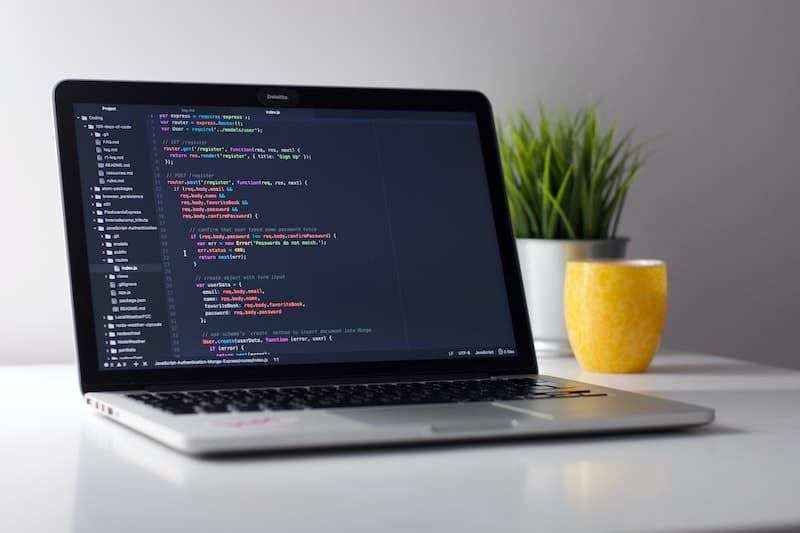
Deciding on the right laptop for programming can be complicated. Considering the cheapest option simply won’t cut it, and it’s easy to get confused while scouring the internet because there are so many laptop models out there. The truth is that you can write code on just about any laptop available today, but your productivity will significantly increase if you use a machine more suited for programming. So, with that said, how do you pick the right laptop for your programming needs?
To pick the right laptop for programming, consider the specs instead of the laptop. It should have a minimum RAM of 4GB, no less than 1920×1080 display, no less than an i5 processor, at least 6 hours battery life, a keyboard with decent travel, a soft-touch keyboard, 2GB graphics card, and no less than 256GB SSD.
In this article, we will explore how to select the best laptop for programming and give you our pick for the best programming laptop in 2021. If this interests you read on to find out more.
How Do I Choose a Laptop for Programming?
The ideal laptop features for developers who are either programmers or designers vary depending on the area. You can use most modern laptops for programming, but the output of the product will be significantly lower than if you used a laptop with the specific features required for programming.
Programming is a tedious and hard job because it requires problem solving and a machine that can handle hosting your application locally for testing purposes. So, for you to work smoothly, you’ll need a device with optimal performance than the normal one so that it delivers the best results.
So, with that said, here are some of the considerations you should make before buying a laptop for programming purposes:
- RAM
The first thing to consider when buying a laptop for programming is the RAM. As a programmer, you’ll have to run multiple heavy applications. If you use a normal laptop or one with little RAM, these applications will hang uncontrollably, making it impossible to work.
The ideal laptop for programming should have a RAM of 8GB. With 4GB RAM, you’ll face many problems since the applications will take their toll on it. However, the best laptop for programming would be one with 16GB RAM, if it’s within your budget, because you will be able to run and test applications locally while programming. There are also different categories of RAM like DDR1 TO DDR4. Always buy the latest model, which is DDR4 currently.
- Display
The screen of a laptop is one of the most important features when it comes to programming. Programming requires you to look at the screen for hours on end so that you can pay close attention to the details.
Most budget laptops will have a display of 1366×768. This is mediocre at best, and such a laptop doesn’t have enough space for multitasking. Also, the text won’t be clear and sharp enough for you to read comfortably. A 4K display for a laptop is overkill especially considering how expensive, such laptops are.
You should ensure you don’t get a laptop with less than Full HD 1920×1080 display (1080p). If you have to pay a little bit extra to get such a laptop, do it. It will be worth it!
- Processor
Your laptop’s processor or CPU makes a huge difference in performance and is therefore quite essential for programming, so you cannot skimp on this. There are many processors with different specifications, but the best for you would be a laptop with Intel i7 quad-core processor because you have to manage heavy programming tasks.
If you don’t want an Intel processor, you can get a newer version of an AMD processor. If you are just starting and have a limited budget, an i5 processor will get the job done.
- Keyboard
Besides the internal hardware, you must also place a lot of emphasis on the laptop’s keyboard. Programmers spend endless hours in front of a laptop coding. Therefore, it’s important to get a laptop with a comfortable keyboard. You should opt for a keyboard with a numerical pad and also one that has decent travel and a soft touch. The quality and sturdiness of the keys are essential because you’ll be using them for extended periods of time.
You should consider the keyboard layout as well. Some laptops have keyboards with odd layouts where some keys are repositioned, which can make writing code hard. If you’ll be working in low-light conditions, having a backlit keyboard will come in handy.
- Battery life
Good battery life may not be so important if you spend a lot of time near a power outlet. You should, however, aim for at least 6 hours of battery life. You shouldn’t rely on the expected battery life as stated by the manufacturer in the specifications. Instead, read third-party ratings from reliable sites and see what users say about the product in forums and reviews.
Getting a laptop with good battery life will prove useful, especially since it will give you the flexibility of working from anywhere without worrying about your laptop turning off.
- Graphics card
The user interface is an integral part of any programming work. So, if you are a programmer, you’ll need a quality graphics card because you will experience hanging and slowing down without it.
A dedicated or discrete graphics card isn’t so important for programming. You will save a lot by going for an integrated graphics card. You should get an integrated graphics card and invest the money you save in getting a better SSD or processor, which will give you better value for your money. A laptop with a 2GB graphics card is enough for programming.
- Cooling pad
This is a commonly neglected feature when considering a laptop for programming. A cooling pad is a must not only for a programming laptop but for regular laptops too. Some laptops come with cooling pads that don’t work so well after some time. This causes the laptop to get hot within a very short time. The hotter it gets, the more its performance drops. You should therefore buy a laptop with fully functional and durable cooling pads.
- Storage type and capacity
Getting an SSD should be at the top of your priority list when looking for a programming computer. It will give you significant performance boosts over a standard hard drive. All your operations, including booting up the OS, compiling code, launching apps, and loading your projects, will be faster with a quality SSD.
The baseline should be a 256GB SSD. If your budget is flexible and you can spend a bit more, a 512GB or 1TB SSD would be better. If the cost is a problem, opt for a smaller SSD where your OS will reside alongside your apps and frequently accessed documents (like project files). You can store the other files like music and videos on an external hard drive or utilize cloud storage.
- Mobility
Laptops come in all shapes and sizes. You’ll have to decide how portable you’d like your laptop to be. If you don’t have to carry your laptop around with you, then you should consider getting a 15-inch laptop. These will usually have better features and more screen space for multitasking.
If you travel a lot or work in different places, a 13 or 14-inch laptop may be ideal for you. These are lighter and still give you great performance and longer battery life. Unless you’re buying a 2-in-1 laptop, a touchscreen laptop isn’t necessary and doesn’t justify the added cost.
In conclusion, most programming laptops will fall within the range of $700-$1500. When choosing a laptop for programming, make sure you pay attention to the specs rather than the price. If your laptop has the sufficient specs, then it should be good enough for programming.
